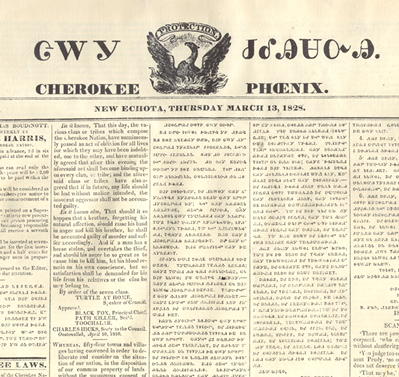|
The Cherokee
Nation of Indians published some 260 issues of a national newspaper
under the titles Cherokee Phoenix and Cherokee Phoenix, and
Indians' Advocate from 1828 to 1834. Both English and Cherokee
language articles appeared in the Phoenix, with approximately
30% of the column space devoted to articles written in the Cherokee
syllabary.
Publication
came at the critical time in Cherokee history, during the Cherokee
"renaissance" and prior to forced removal of the Cherokee
Nation to Indian Territory in 1838.
By
the late 1700s, the newly inaugurated United States began to
supplant European dominance in the Southeast. As the United
States asserted political, social and demographic control over
the Southeast, its relations with the Cherokees and other Native
American nations altered. A significant Native American population
lived within borders of the eastern states. Also, the Southeastern
Indian nations still held claim to thousands of square miles
of land in the Southern states.
Policy
in the first years of the republic encouraged acculturation
and possible assimilation into the dominant Anglo-American society.
Latter policy promoted removal of Native Americans and resettlement
outside existing state boundaries as an option. Such a removal
became a possibility with the Louisiana Purchase in 1803. A
determination to extinguish Indian title to lands east of the
Mississippi River intensified after 1828 with the election of
Andrew Jackson as President and in 1830 when Congress approved
the Indian Removal Act.
Amid
conflicting policies of assimilation and removal, the Cherokees
came to the fore of national attention with the Cherokee Nation's
struggle to maintain its integrity, retain diminished homelands,
and organize as a political entity. Confronted with mounting
pressure to cede more lands and the possibility of tribal disintegration,
the Cherokees experienced a "renaissance" of cultural
development and purpose. Cherokee achievements in the 1820s
included agrarian improvements, the construction of roads, the
application of mechanical arts, a concern for the education
of their youth, social reform movements, formal organization
of a Cherokee national government, and the development by Sequoyah
of a written Cherokee language. In addition, in 1826 the Cherokee
government authorized "that a person be appointed whose
duty it shall be to edit a weekly newspaper at New Echota, to
be entitled, the 'Cherokee Phoenix' . . . ."

View Complete History Resource Here:
The
Cherokee Phoenix From Hunter Library
Other
Web Links Referencing Cherokee
Phoenix
Cherokee
Phoenix
Cherokee
Phoenix Archives
|